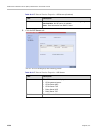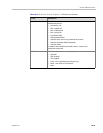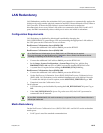
Chapter 16-Network Services
Polycom, Inc. 16-41
Network Traffic Control
The Network Traffic Control mechanism controls the level of UDP packets generated by the
system. It regulates a set of queuing systems and mechanisms by which UDP packets are
received and “transmitted” to the network router.
During a conference the MPMx cards occasionally blast-out UDP packets which can cause
overloads on the network. Collaboration Server bandwidth usage can increase to above the
designated conference participant line rate settings, causing network bandwidth issues such
as latency and packet loss.
Three Network Traffic Control Flags are used to control the Network Traffic mechanism:
• ENABLE_TC_PACKAGE
When the flag is set to NO (default), Network Traffic Control is disabled on the
Collaboration Server. Set the flag to YES to enable Network Traffic Control.
• TC_BURST_SIZE
This flag regulates the Traffic Control buffer or maxburst size as a percentage of the
participant line rate. In general, higher traffic rates require a larger buffer. For example,
if the flag is set to 10 and the participants line rate is 2MB, then the burst size is
200Kbps.
Default = 10
Flag range: 1-30.
• TC_LATENCY_SIZE
This flag limits the latency (in milliseconds) or the number of bytes that can be present
in a queue.
Default = 500
Flag range: 1-1000 (in milliseconds).
SIP Proxy Failover With Polycom® Distributed Media
Application™ (DMA™) 7000
Collaboration Server systems that are part of a DMA environment can benefit from DMA’s SIP
Proxy Failover functionality.
SIP Proxy Failover is supported in DMA’s Local Clustering mode with redundancy achieved
by configuring two DMA servers to share a single virtual IP address.
The virtual IP address is used by the Collaboration Server as the IP address of its SIP Proxy.
No additional configuration is needed on the Collaboration Server.
Should a SIP Proxy failure occur in one of the DMA servers:
• The other DMA server takes over as SIP Proxy.
• Ongoing calls may be disconnected.
• Previously ongoing calls will have to be re-connected using the original IP address,
registration and connection parameters.
• New calls will connect using the original IP address, registration and connection
parameters.
Only supported in the MPMx Card Configuration mode.


















